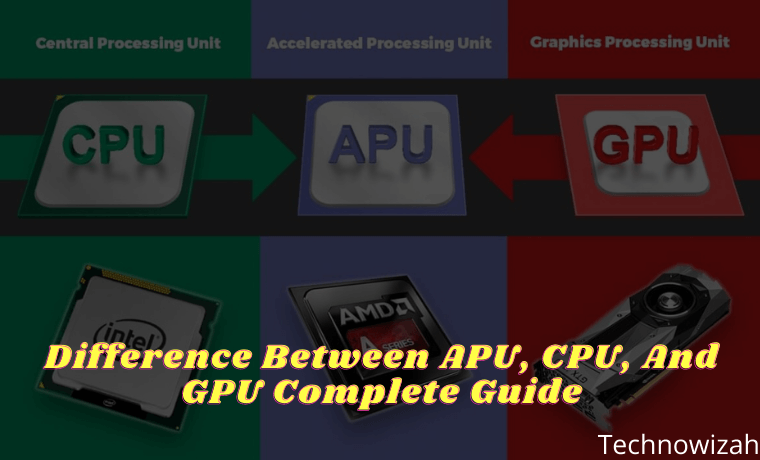What Is The Difference Between APU CPU And GPU – When we buy a new computer, knowing the difference between a CPU, GPU, and APU is a pretty big advantage. It can even save you money.

What Is The Difference Between APU CPU And GPU 2024
Especially if you are planning to build your own PC. The three technologies are often grouped but have different roles. Knowing the function of each of the three technologies is also very important. So, what exactly is the difference between APU, CPU, and GPU?
Central Processing Unit (CPU)
The Central Processing Unit, or CPU, is the main brain of the computer. Initially, the CPU was spread across multiple chips. However, to increase efficiency and reduce manufacturing costs, the CPU is now contained within a single chip. These smaller CPUs are also referred to as microprocessors.
- 8 Ways to Check VGA on Windows 10 Laptop PC
- 7 Ways To Open Windows Task Manager on Windows10 PC
- What is The Definition of Software Functions Are Discussed
- 10 Best Free Premium KWGT Widgets for Android
Desktop computers can be found as all-in-one devices, laptops continue to get thinner but with more powerful performance, and some smartphones are now more powerful and faster.
The CPU does the core computing process for your computer. Instructions stored in your device’s RAM are sent to the CPU for execution. It is a three-part system consisting of the Fetch, Decode, and Execute stages. In general, this means accepting input, understanding what is meant, and creating the desired output.
Using this, your CPU helps with everything from loading the operating system, to opening programs, and even doing spreadsheet calculations. Resource-heavy operations like video games place the most significant load on your CPU. This is why benchmarking tests are usually conducted against game standards.
CPUs are available in many varieties from energy-efficient single-core chips to high-performance Octa-core chips. Intel uses Hyper-Threading technology to make a quad-core CPU act as if it were an octa-core. This helps force most of the power and efficiency out of your CPU.
Graphics Processing Unit (GPU)
For all the progress made with CPUs, they still have a drawback, namely graphics. The CPU takes input and works through it in circular steps. However, graphics processing requires a lot of data to be processed simultaneously. Graphics Processing Unit (GPU), reduces work on CPU and improves your video performance.
Most computers and laptops are equipped with a CPU and GPU, but this is not always the case. Sometimes, especially at lower price ranges, your computer will come with graphics built into the motherboard instead of a dedicated GPU.
Both GPU and CPU perform the same function, but the way they do it is different. The parallel structure of the GPU is specially adapted for its purpose. This helps the unit achieve the billions of calculations per second required for gaming and video. The GPU is often located on a separate graphics card, which also has its own RAM.
This allows the card to store the data it generates. Thanks to this internal RAM, the GPU can generate a buffer, storing the finished image until you need to display it. This is especially useful when watching videos, for example.
Accelerated Processing Unit (APU)
To reduce physical size and manufacturing costs, manufacturers have found ways to combine electronic components into a single chip. The newest way of this technology is the System-on-a-Chip (SoC) device. In this design, all major electronics are combined into one die. This enabled the growth of inexpensive computers and smartphones.
SoC technology also has its predecessor, the Accelerated Processing Unit or APU. These units combine the CPU and GPU into a single chip to form a combined processing unit. This not only reduces costs but also increases efficiency. Minimizing the physical distance between the two allows for faster data transfer and increased performance.
Since the GPU is optimized for faster computational speeds, the CPU can output some work to the GPU. In a separate setup, the efficiency gains from this load sharing will be undermined by the physical distance and data transfer rates between the two. However, the combined APU does make this achievement possible.
However, the APU doesn’t deliver the same performance as a dedicated CPU and GPU. On the contrary, this technology is more suitable than integrated graphics. If you upgrade the APU, you will get a more affordable price.
Processor manufacturer AMD develops APUs. However, they are not the only ones to incorporate processors in this way. Intel is also starting to integrate CPU and GPU as well. The main difference is that AMD releases a dedicated line of APUs, whereas Intel and other companies incorporate them into their product line.
APU vs CPU vs GPU
Now you know the difference between APU, CPU, and GPU. If you opt for a separate CPU and GPU, you’ll likely end up spending more money, but you’ll also get a more significant performance boost.
Conclusion:
But if you choose APU you can save budget but with standard performance. If you are currently running with integrated graphics or graphics embedded directly in the processor, then the APU is the right choice for you to upgrade.
Don’t forget to bookmark and always visit every day Technowizah.com because you can find here the latest Tech Computer Android games How-to Guide Tips&Tricks Software Review etc, Which we update every day.


![6 Ways to Fix System Thread Exception Not Handled in Windows 10 [2024] 6 Ways to Fix System Thread Exception Not Handled in Windows 10](https://technowizah.com/wp-content/uploads/2021/07/6-Ways-to-Fix-System-Thread-Exception-Not-Handled-in-Windows-10-218x150.jpg)








![10+ Ways To Take Screenshot on Asus Laptop Windows 10 [2024] How To Take Screenshot on Laptop and PC Windows](https://technowizah.com/wp-content/uploads/2020/06/How-To-Take-Screenshot-on-Laptop-and-PC-Windows-100x70.jpg)
